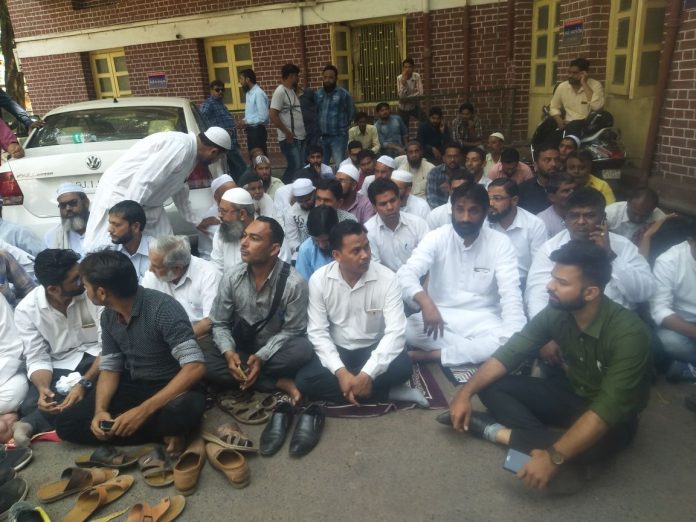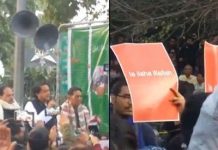By Abdul Hafiz Lakhani
Ahmedabad: Close on the heels of Chhatral violence in Gujarat, it seems that after urban communal polarisation, it is now rural areas which are on the hit list of RSS-led Hindutva footsoldiers in Gujarat.
Farzan Saiyed, the 32-year-old man attacked by alleged Hindutva goons in Chhatral in Gandhinagar district on 5th March, succumbed to his injuries recently. His 52-year old mother Roshanbiwi Saiyed was also attacked by the goons, who mercilessly chopped off three of her fingers. She is still recovering in hospital.
It appears that Hindutva groups are now targeting rural Gujarat, particularly north Gujarat, to destroy the social fabric as this is the region where Hindus and Muslims have lived relatively peacefully. It must also be remembered that the BJP had to face a drubbing in rural Gujarat during the state assembly polls last year.
The episode is a pointer as to how the Hindutva groups are continuing to stoke the fire of communalism to keep the cauldron simmering. But what Chhatral has witnessed over the last four months is a sign of the changing face of communal strategy being kept alive in Gujarat which is quite often referred to as the laboratory of Hindutva.
In Chhatral, the efforts to polarise began in the run-up to the elections in December. Sources say that on December 6, activists of the Vishwa Hindu Parishad (VHP) and Bajrang Dal carried out a ‘Swabhiman Yatra’ to mark the demolition of the Babri Mosque in Ayodhya in 1992. The Yatra was carried out in the Qasba area where there are around 290 Muslim houses and the song ‘Bharat mein jo rehna hoga, Vande Matram kehna hoga’ was played over and over again.
One month down the line, on January 7 VHP leader Pravin Togadia allegedly presided over a function where tridents and swords were distributed. The pictures of the event were circulated widely on social media.
Sources say that that on January 20, a scuffle broke out between Hindutva activist Ankit Narniya who is also a Dalit, and a Muslim youth Akram Syed. “This was an attempt to give it a colour of a Dalit-Muslim clash. A case was registered and while Akram was arrested immediately, Ankit was arrested some days later. This also showed how they are rankled by the equation of Dalits and Muslims coming together,” says Shamshad Khan Pathan, an advocate and a social activist with Alp Sankhyak Adhikar Manch (ASAM) who has been chronicling the developments in Chhatral.
On January 21 a door and a gate to a Dargah were broken and this was followed by around 300 people handing over a memorandum to the police and administrative authorities on January 23.
Then again on January 26, a Bihari Muslim labourer working at a roadside eating joint selling egg preparations was thrashed by people affiliated to a Hindutva organisation.
On Shivratri a fair was organised very close to the Qasba area and a Muslim youth selling balloons was thrashed. This was followed by a Ram temple being damaged some days later and messages were circulated holding the Muslims responsible for the act, even though no evidence has been found to that effect.
Local Muslims along with the ASAM have been demanding an investigation into the matter to ascertain who was behind the act. Sources said that a mob had gone to the Muslim area with the intention of starting an altercation but the Muslims preferred to remain indoors. This was followed by the mob entering into a skirmish with the police which led to 16 people being booked and nine being arrested.
On March 5, 52-year old Roshanbiwi and her son Farzan were attacked allegedly by Bajrang Dal activists when they were on the way graze their animals. They chopped off her left thumb, index finger and middle finger of 52 year-old Roshan Banu were chopped off and broke Farzan’s arms and a leg broken, besides hitting him on the head. Farzan passed away on March 12 at Ahmedabad’s VS Hospital where various Muslim organisations staged a protest.
“Ironically, just after his death the police were able to arrest those whom he had named in his dying declaration. Some of the arrests were made in Goa which means that their whereabouts were known. In the events preceding the attack on the mother and son, the police had been registering cases but the arrests were negligible,” Catch News reported Shamshad as narrating the ordeal.

The protestors pointed out that they had been constantly reminding the authorities that communal tensions were building up in Chhatral but the government did not take any action. They say that Farzan was killed because of utter negligence on the part of the government and its failure to maintain law and order. His burial was held on late Monday evening. ASAM activists have demanded compensation for his family members.
There have been reports of heavy police deployment in Chhatral where people are even scared to send their children to school to give their board exams.
Authorities have reportedly said that the police and district administration have been monitoring the situation and are in the process of engaging local teachers to bring students to examination centres.
“What is at display is the changing face of the communal strategy of Hindutva groups. One needs to also keep in mind the attack on Muslims in Vadavali village of Patan district last year. The model has changed. What is visible now are consistent small scale high intensity attacks in the form of damaging houses and shops. There is no curfew and the issue never gets reported prominently. The BJP has not done well in rural areas in the elections till now and this is the ground being targeted by those who want political dividends from communal polarisation. This is a very dangerous trend,” said Shamshad.
Observers say that efforts will be made by fringe groups to ensure that the communal cauldron continues to simmer in Gujarat as the country gets into the poll mode for the 2019 Lok Sabha elections. They say that low intensity communal strife also helps the political forces divert attention from main issues concerning the electorate, such as water scarcity, agrarian distress and unemployment.
A day after Farnaz Saiyed, 33, died in Ahmedabad’s VS Hospital. He was earlier severely beaten up by a group of youths, allegedly owing allegiance to the Bajrang Dal, half-a-dozen policemen stood deployed outside the family’s home in Chhatral, a village in Kalol taluka of Gandhinagar district, on Tuesday. More than a dozen men in uniform patrolled elsewhere in the village, most of them deployed near a dairy office, located close to the schools and panchayat office. “There is tension in the village but the situation is under control,” a policeman said.
There is a reason for extra deployment outside the dairy office. It lies in the “Hindu area” of the village, residents said. Mohammad Hussain Saiyed, 70, a farm labourer, and Farnaz’s father, said he sold his eight buffaloes over the last two months due to the festering tension between the communities. He has also stopped going to deposit milk at the milk collection centre – it is in the Hindu area, and he is scared, he admitted.
In the attack on the morning of March 5, Saiyed’s wife Roshan Bano, in her sixties, was also beaten up – three of her fingers were chopped off. She is still in hospital. Like Saiyed, almost everyone from the Muslim community has stopped selling milk at the collection centre, a fact confirmed by a policeman posted outside the dairy office.
There are about 250 to 300 Muslim households and nearly 2,000 Hindu households in Chhatral, situated on Gandhinagar-Mehsana Highway. Due to the tension many Muslim children have stopped going to school, as both the primary and the higher secondary sections are in the Hindu area. On Monday, the first day of the Board examination, 13 students from the minority community reached A L Zaveri High School escorted by the police to sit for their papers.
“We heard there is tension and that’s why we have made all arrangements for their safety. They appeared in the exams on Monday peacefully,” school principal Mahendra Bavariya said. “There has been a decline in the number of Muslim students’ attendance but meritorious students never skipped classes,” he added.
“We have completely stopped going to the Hindu locality which has the village’s schools, post offices, dairy and panchayat offices. Although there is no obvious threat per se, we don’t send our children to school out of fear,” said Fakruddin Saiyed, 43, who lives close to Farnaz’s house.
In the last two weeks, 13 youths have been arrested – seven of them Hindus, including children of sarpanch and deputy sarpanch, booked for murder, and six Muslims, including son of a businessman, accused of attempt to murder. Senior police officers said tension between the communities stem from a case of atrocity lodged in 2014 against one Akram by Ankit Nadia, who was among those arrested from Goa on Monday. There have been attempts to withdraw the case when it came up for trial but the negotiations turned violent due to involvement of the sons of community leaders, locals said.
With many houses in the Hindu and Muslim neighbourhoods sharing walls, residents said there was no tension in the past – that they lived peacefully even in 2002 post-Godhra riots. There are misgivings galore since then. Muslim residents alleged that there is a “surge of activities of Bajrang Dal and VHP, which has led to the current situation.” Hindu villagers, however, said these organisational activities have always existed.
Muslim residents claim that the ongoing bout of tension started following a Bajrang Dal procession in the first week of December last year, allegedly to commemorate the Babri Masjid demolition. They said it performed a deeksha celebration where trishuls (tridents) were distributed.
But Bajrang Dal leaders said they have organised this event for several years. “Ankit Nadia was beaten up by Akram and others in 2014 and last year the case came up for trial. Since then, Nadia is being harassed to withdraw the case. We are supporting Nadia, who is a Dalit…he is poor,” said Piyush, a young man associated with Bajrang Dal who refused to disclose his surname.
The animosity between the communities has so far resulted in at least four FIRs – cross-complaints, most of them – since December 2017. Nadia’s family members, booked for killing Farnaz, have left the village fearing police action. By Tuesday, all seven accused were caught and produced before a local court. Gandhinagar SP Virendra Yadav said, “The situation is under control. There have been talks between leaders of the two communities, and more than two dozen policemen are deployed in the village to tackle any situation.”
(With some inputs from The Indian Express and CatchNews.com)
[Abdul Hafiz Lakhani is a senior Journalist based at Ahmedabad, Gujarat. He is also Editor of Siyasat.net He can be reached at editor [ @ ] siyasat.net]


































